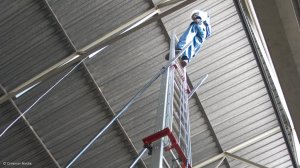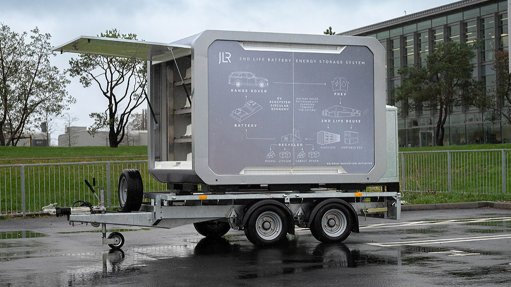Rules, regulations reinforced to minimise fatalities



SCAFFOLDING DANGERS Workers that use scaffolding have to use harnesses secured to the correct anchor points
DANGEROUS LADDERS Ladders on construction sites can be dangerous if not properly used
With the biggest cause of fatalities in the working at height industry being workers falling from height, the Institute for Working at Height (IWH), together with the Department of Labour (DoL), is reinforcing rules and regulations within the industry that will assist in minimising these fatalities.
One of the steps that has been taken to ensure safety has been the redefining of working at height, which was previously defined as work taking place from a height of at least 2 m off the ground. Lately, this was changed to work taking place any time from when a worker leaves the ground to do a certain job.
“The debate for what should be considered working at height in South Africa has been ongoing for some time. However, after many meetings, debates, incidents and discussions with industry professionals, companies working in the industry and the DoL, the definition was updated,” says IWH CEO Dr Alti Kriel.
“When minor tasks need to be completed, workers might use scaffolding, ladders, mobile elevating work platforms or ropes without going through proper training and safety procedures, thinking that because of the task only requiring a short amount of time, nothing can go wrong. The thinking behind it is that no accidents can take place during minor jobs such as changing a light bulb while standing on a ladder, however, this kind of thinking is dangerous as fatalities can occur at any time,” Kriel points out.
Owing to the risk of falling when working at height, the IWH has strengthened the implementation of regulations for workers that are at height. Further, new training programmes are being introduced to help employers ensure the safety of their workers.
Because of a lack of national qualifications framework (NQF) qualifications for certain work at height access methods – for example ladders – the IWH’s Towers and Ladders chamber has developed training outcomes to train workers that use ladders on construction sites. Kriel explains ladders could be a safe method for accessing height if is used properly and, therefore, proper training is necessary.
What is imperative is that all people working at height should be properly trained. The Construction Regulations 2014 is very clear on what the definition of ‘competence’ is. If an NQF-registered qualification is available, that should be the qualification the person should have to be able to work at height.
She points out that there are approximately 20 accredited training providers across the country that have been recognised by the IWH to conduct work at height-related training. These providers are audited on a regular basis to ensure that they are not just training according to high standards but also according to the relevant legal requirements as set out in the Occupational Health and Safety Act and the Construction Regulations.
The correct training is very important. Kriel explains that workers are sometimes aware that a harness is required when working at height. Further, workers have in the past hooked their fall arrest harness onto a loose standing aluminium scaffold and fallen, pulling the scaffold on top of themselves.
Workers trained at an IWH-recognised training provider will be registered against the South African Qualifications Authority-registered designations. To validate if your employees are properly trained and registered with the IWH, one can access the website and click on ‘Validate a Practitioner’, add the ID number and it will immediately show if the person is properly qualified to do the job at hand.
She concludes that the IWH is currently also busy developing a new website, which will allow for easier access to new regulations and a list of the member companies.
Comments
Press Office
Announcements
What's On
Subscribe to improve your user experience...
Option 1 (equivalent of R125 a month):
Receive a weekly copy of Creamer Media's Engineering News & Mining Weekly magazine
(print copy for those in South Africa and e-magazine for those outside of South Africa)
Receive daily email newsletters
Access to full search results
Access archive of magazine back copies
Access to Projects in Progress
Access to ONE Research Report of your choice in PDF format
Option 2 (equivalent of R375 a month):
All benefits from Option 1
PLUS
Access to Creamer Media's Research Channel Africa for ALL Research Reports, in PDF format, on various industrial and mining sectors
including Electricity; Water; Energy Transition; Hydrogen; Roads, Rail and Ports; Coal; Gold; Platinum; Battery Metals; etc.
Already a subscriber?
Forgotten your password?
Receive weekly copy of Creamer Media's Engineering News & Mining Weekly magazine (print copy for those in South Africa and e-magazine for those outside of South Africa)
➕
Recieve daily email newsletters
➕
Access to full search results
➕
Access archive of magazine back copies
➕
Access to Projects in Progress
➕
Access to ONE Research Report of your choice in PDF format
RESEARCH CHANNEL AFRICA
R4500 (equivalent of R375 a month)
SUBSCRIBEAll benefits from Option 1
➕
Access to Creamer Media's Research Channel Africa for ALL Research Reports on various industrial and mining sectors, in PDF format, including on:
Electricity
➕
Water
➕
Energy Transition
➕
Hydrogen
➕
Roads, Rail and Ports
➕
Coal
➕
Gold
➕
Platinum
➕
Battery Metals
➕
etc.
Receive all benefits from Option 1 or Option 2 delivered to numerous people at your company
➕
Multiple User names and Passwords for simultaneous log-ins
➕
Intranet integration access to all in your organisation




















